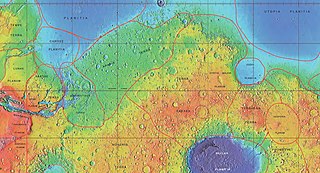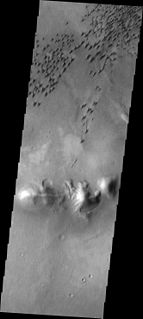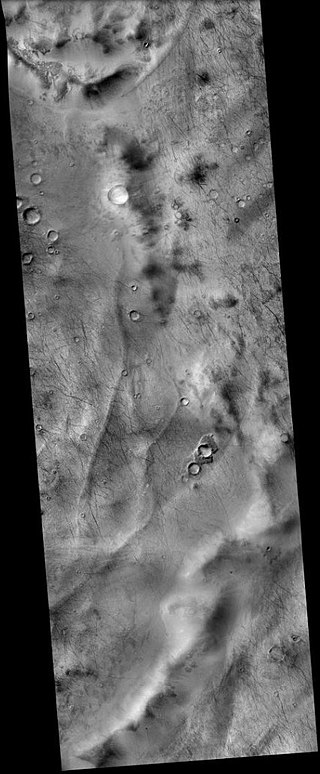
A ridge or a mountain ridge is a geological feature consisting of a chain of mountains or hills that form a continuous elevated crest for some distance. The sides of the ridge slope away from narrow top on either side.The line along the crest formed by the highest points, with the terrain dropping down on either side, is called the ridgeline. Ridges are usually termed hills or mountains as well, depending on size.

The Lomonosov Ridge is an unusual underwater ridge of continental crust in the Arctic Ocean. It spans 1,800 kilometres (1,100 mi) between the New Siberian Islands over the central part of the ocean to Ellesmere Island of the Canadian Arctic Archipelago. The ridge divides the Arctic Basin into the Eurasian Basin and the Amerasian Basin. The width of the Lomonosov Ridge varies from 60 to 200 kilometres. It rises 3,300 to 3,700 metres above the 4,200-metre (13,800 ft) deep seabed. The minimum depth of the ocean above the ridge is less than 400 metres (1,300 ft). Slopes of the ridge are relatively steep, broken up by canyons, and covered with layers of silt.

Mendeleyeva is a stratovolcano located in the southern part of Kunashir Island, Kuril Islands, Russia.

Tempe Terra is a heavily cratered highland region in the northern hemisphere of the planet Mars. Located at the northeastern edge of the Tharsis volcanic province, Tempe Terra is notable for its high degree of crustal fracturing and deformation. The region also contains a large number of small shield volcanoes, lava flows, and other volcanic structures.

Terra Sabaea is a large area on Mars. Its coordinates are 2°N 42°E and it covers 4,700 kilometres (2,900 mi) at its broadest extent. It was named in 1979 after a classic albedo feature on the planet. Terra Sabaea is fairly large and parts of it are found in five quadrangles: Arabia quadrangle, Syrtis Major quadrangle, Iapygia quadrangle, Ismenius Lacus quadrangle, and Sinus Sabaeus quadrangle.
The continental shelf of Russia is a continental shelf adjacent to Russia. Geologically, the extent of the shelf is defined as the entirety of the continental shelves adjacent to Russia's coast. In international law, however, the United Nations Convention on the Law of the Sea more narrowly defines the extent of the shelf as the seabed and subsoil of the submarine areas over which a state exercises sovereign rights.

Mendeleyevskaya is a Moscow Metro station on the Serpukhovsko-Timiryazevskaya Line. It is located in the Tverskoy District of central Moscow.

Wirtz is a crater on Mars, located in Argyre quadrangle at 48.6° south latitude and 26° west longitude. It measures approximately 120 kilometers in diameter and was named after Carl Wilhelm Wirtz, a German astronomer (1886–1956). The name was adopted by IAU's Working Group for Planetary System Nomenclature in 1973. Wirtz lies on the eastern edge of the large impact crater Argyre Planitia.

Arkhangelsky Crater is a crater in the Argyre quadrangle of Mars, located at 41.4° S and 24.8° W. It is 117 km across and was named after the Russian geologist A.D. Arkhangelsky.
Green Crater is an impact crater in the Argyre quadrangle of Mars, located at 52.7° S and 8.4° W. It is 184.0 km in diameter and was named after Nathan E. Green, a British astronomer (1823-1899).

Mendeleev readings — a solemn act, the annual reports of leading Soviet/Russian scholars on topics affecting all areas of chemistry and its related sciences: physics, biology and biochemistry. Date of readings is due to two dates: birthday of Dmitri Mendeleev, and sending messages to them on the opening Periodic Law.
A concentric crater fill is a landform where the floor of a crater is mostly covered with a large number of parallel ridges. It is common in the mid-latitudes of Mars, and is widely believed to be caused by glacial movement. Areas on Mars called Deuteronilus Mensae and Protonilus Mensae contain many examples of concentric crater fill.
Fang Glacier is a glacier on the west side of Fang Ridge, separating the old and new craters of Mount Erebus on Ross Island. It was charted by Frank Debenham of the British Antarctic Expedition, 1910–13, and named by him in association with Fang Ridge.

Mendeleyev Glacier is a glacier, 10 nautical miles (19 km) long, draining northeast through the northern outcrops of the Payer Mountains, in Queen Maud Land, Antarctica. It was mapped from air photos and surveys by the Soviet Antarctic Expedition, 1960–61, and named after Russian chemist Dmitri Mendeleev, whose surname may also be transliterated as "Mendeleyev".

Brain terrain, also called knobs-brain coral and brain coral terrain, is a feature of the Martian surface, consisting of complex ridges found on lobate debris aprons, lineated valley fill and concentric crater fill. It is so named because it suggests the ridges on the surface of the human brain. Wide ridges are called closed-cell brain terrain, and the less common narrow ridges are called open-cell brain terrain. It is thought that the wide closed-cell terrain contains a core of ice, and when the ice disappears the center of the wide ridge collapses to produce the narrow ridges of the open-cell brain terrain. Shadow measurements from HiRISE indicate the ridges are 4-5 meters high. Brain terrain has been observed to form from what has been called an "Upper Plains Unit." The process begins with the formation of stress cracks. The upper plains unit fell from the sky as snow and as ice coated dust.

Lau Crater is an impact crater in the Mare Australe quadrangle of Mars, located at 74.4°S latitude and 107.8°W longitude. It is 104.9 km in diameter. It was named after Danish astronomer Hans E. Lau, and the name was approved in 1973 by the International Astronomical Union (IAU) Working Group for Planetary System Nomenclature (WGPSN).
The Mendeleev Tank was a proposed early tank design by Russian naval engineer Vasiliy Mendeleev, son of Russian scientist Dimitri Mendeleev, who created the modern periodic table. The vehicle was envisioned by Mendeleev during his time working at the Kronshtadt Marine Engineering School in Saint Petersburg, Russia, from 1911 to 1915. Its purported purpose was to be an ultra-heavy "landship" immune to all enemy fire and able to cross large battlefields while providing heavy artillery support to troops using a 120 mm gun. The proposed tank was one of the heaviest tanks of all time, at 173.2 tons, it would have been just a dozen tons lighter than the German Maus superheavy tank of World War II.














